#farmer nix
Text





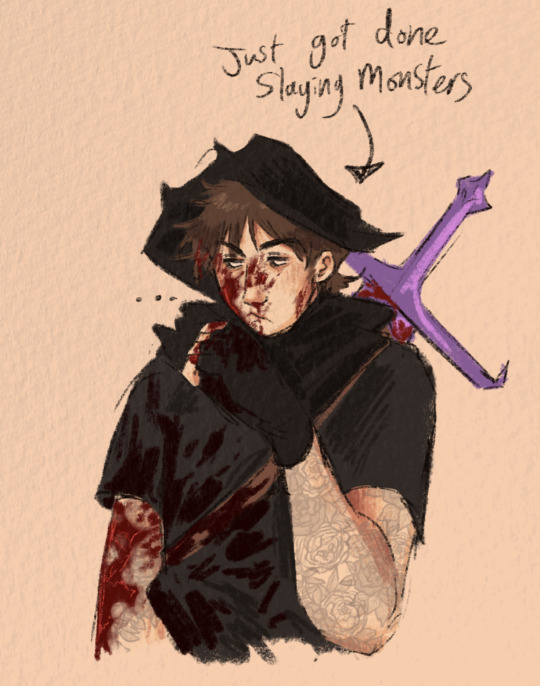
Nix and Shane :)
#idk i don’t have much to say im just being self indulgent#art#my art#fanart#sdv shane#stardew valley#sdv#shaneposting#farmer nix#stardew valley shane#stardew valley farmer#sdv farmer#stardew valley oc
1K notes
·
View notes
Text
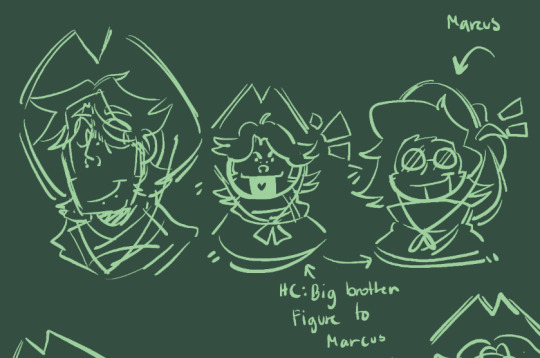




Lil hc he does the little brotherly head rub to Marcus /pos I GOT TH ELITLTE IDEA WITH YOUR BROTHERLY INSTICTS MENTION,,, AND I THINK THATS CUTE... /POS
bigman @neotomiccccc /pos
#sdv#stardew valley#sdv farmer#stardew#stardew farmer#art#farmer nix#farmer marcus#i hope ON GOD I DID NOT RUIN HIS HAIR
12 notes
·
View notes
Text
John Deere's repair fake-out

Last week, a seeming miracle came to pass: John Deere, the Big Ag monopolist that — along with Apple — has led the Axis of Evil that killed, delayed and sabotaged dozens of Right to Repair laws, sued for peace, announcing a Memorandum of Understanding with the American Farm Bureau Federation to make it easier for farmers to fix their own tractors:
https://www.fb.org/files/AFBF_John_Deere_MOU.pdf
This is a move that’s both badly needed and long overdue. Deere abuses copyright law to force farmers to pay for official repairs — even when the farmer does the repair. That’s possible thanks to a practice called VIN locking, in which engine parts come with DRM that prevents the tractor from recognizing them until they pay hundreds of dollars for a John Deere technician to come to their farm and type an unlock code into the tractor’s console:
https://doctorow.medium.com/about-those-kill-switched-ukrainian-tractors-bc93f471b9c8
Like all DRM, VIN locks are covered by Section 1201 of the Digital Millennium Copyright Act (DMCA), a 1998 law that criminalizes distributing tools to bypass “access controls,” even if you do so for a lawful purpose (say, to fix your own tractor using a part you paid for). Violations of DMCA 1201 carry a penalty of 5 years in prison and a $500k fine — for a first offense.
This means that Deere owners are locked into using Deere for repairs, which also means that if Deere decides something isn’t broken, a farmer can’t get it fixed. This is very bad news indeed, because John Deere tractors are just computers in a fancy, mobile case, and John Deere is incredibly bad at digital security:
https://pluralistic.net/2021/04/23/reputation-laundry/#deere-john
That’s scary stuff, because John Deere is a monopolist, and a successful attack on the always-connected, networked tractors and other equipment it supplies to the world’s farmers could endanger the global food supply.
Deere doesn’t want to make insecure tractors, but it also doesn’t want to be embarrassed by security researchers who point out that its security is defective. Because security researchers have to bypass Deere tractors’ locks to probe their security, Deere can leverage DMCA1201 into a veto over who gets to warn the public about the mistakes it made.
It’s not just security researchers that Deere gets to gag: the company uses its repair monopoly to threaten farmers who complain about its business practices, holding their million-dollar farm equipment hostage to their silence:
https://pluralistic.net/2022/05/31/dealers-choice/#be-a-shame-if-something-were-to-happen-to-it
This all adds up to what Jay Freeman calls “felony contempt of business model,” an abuse of copyright law that allows a monopolistic corporation to reach beyond its own walls and impose its will on it customers, critics and competitors:
https://locusmag.com/2020/09/cory-doctorow-ip/
If Deere was finally suing for peace in the Repair Wars, well, that was wonderful news indeed — as I said, a seeming miracle.
But — like all miracles — it was too good to be true.
The MOU that Deere and the Farm Bureau signed is full of poison pills, gotchas, fine-print and mendacity, as Lauren Goode documents in her Wired article, “Right-to-Repair Advocates Question John Deere’s New Promises”:
https://www.wired.com/story/right-to-repair-advocates-question-john-deeres-new-promises/
For starters, the MOU makes the Farm Bureau promise to end its advocacy for state Right to Repair bills, which would create a repair system governed by democratically accountable laws, not corporate fiat. Clearly, Deere has seen the writing on the wall, after the passage in 2002 of Right to Repair laws in New York and Colorado:
https://www.eff.org/deeplinks/2022/06/when-drm-comes-your-wheelchair
These two bills broke the corporate anti-repair coalition’s winning streak, which saw dozens of state R2R bills defeated:
https://pluralistic.net/2021/05/26/nixing-the-fix/#r2r
Deere’s deal-with-the-devil is a cynical ploy to brake R2R’s momentum and ensure that any repairs are carried out on Deere’s terms. Now, about those terms…
Deere’s deal offers independent repair shops access to diagnostic tools and parts “on fair and reasonable terms,” a murky phrase that can mean whatever Deere decides it means. Crucially, the deal is silent on whether Deere will supply the tools needed to activate VIN locks, meaning that farmers will still be at Deere’s mercy when they effect their own repairs.
What’s more, the deal itself isn’t legally binding, and Deere can cancel it at any time. Once you dig past the headline, the Deere’s Damascene conversion to repair advocacy starts to look awfully superficial — and deceptive.
One person who wasn’t fooled is sick.codes, the hacker who has done the most important work on reverse-engineering Deere’s computer systems, culminating in last summer’s live, on-stage hack of a John Deere tractor at Defcon:
https://pluralistic.net/2022/08/15/deere-in-headlights/#doh-a-deere
Shortly after the announcement, Sick.codes tweeted how the fine-print in the MOU would have prevented him from doing the work he’s already done (including “a direct stab at me lol”):
https://twitter.com/sickcodes/status/1612484935495057409
As with other instances of monopolistic, corporate copyfraud — like, say, the deceptive Open Gaming License — the John Deere capitulation is really a bid to take away your rights, dressed up as a gift of more rights:
https://mostlysignssomeportents.tumblr.com/post/706163316598407168/good-riddance-to-the-open-gaming-license
[Image ID: Hieronymus Bosch's painting, 'The Conjurer.' The Conjuror's shell-game table holds a small John Deere tractor that the audience of yokels gawps at. One yokel is wearing a John Deere hat. The conjurer is holding a wrench.]
1K notes
·
View notes
Text
Namibia 2023/24 - Tag 4
Herrschaften und Oukies!
Was ist das für ein Stress hier!

Da will man Urlaub machen und hat einen dicht getakteten Stundenplan. Von wegen ausschlafen, nix da.

Um 8 Uhr gibt es wieder Frühstück für alle zusammen.

Dann heißt es: Sonnencreme auftragen, Hut aufsetzen, Getränke mitnehmen und los geht es zur Kontrollfahrt über die Farm.

Heute wurde der alte Chevy genutzt, der auch schon über 5 Jahrzehnte auf dem Buckel hat.

Die Farm hat über 100 Farmtore, die alle geöffnet und natürlich auch wieder geschlossen werden müssen, wenn wir hindurch fahren.

Zuerst geht es zu den einzelnen Posten mit den Rindern.

Dabei stellten wir heute fest, dass die Wasserpumpe nicht funktionierte und über 100 Rinder ohne Wasser da standen.
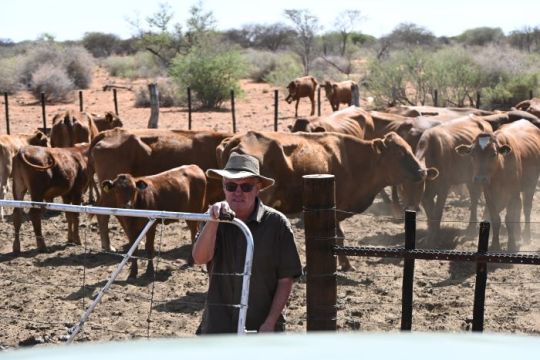
Rainer schickte umgehend seinen "Lehrling" Marcel und seinen Angestellten Karel raus, um Wasser zu fahren.

Kilometer um Kilometer wird der Zaun abgefahren.

Die Feuerschneise zu den Nachbarn wird dabei genau so kontrolliert, wie das Wachstum der einzelnen Grasbüschel.

Mittags erreichen wir wieder die Farm.
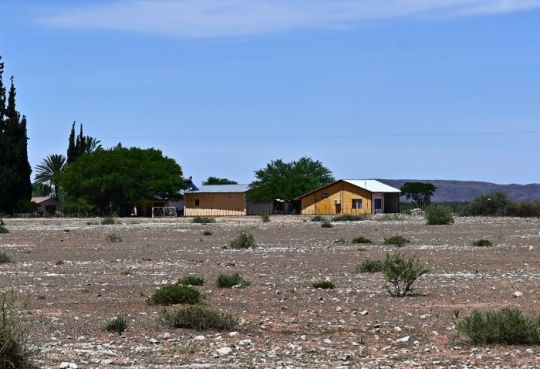
Das gibt uns kurz die Gelegenheit uns frisch zu machen und dann müssen wir auch schon wieder los zum gemeinsamen Mittagessen.

Mittag gegessen wird pünktlich um 12.30 Uhr. Es gibt noch einmal die super leckeren Frikadellen vom Kudu.
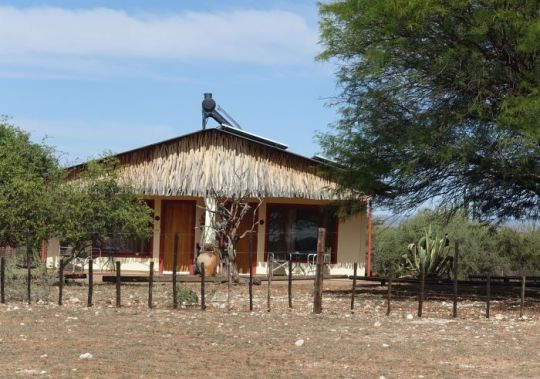
Jetzt haben wir er einmal frei bis zum späten Nachmittag.

Das gibt uns die Gelegenheit uns ein bisschen hinzulegen und zu schlafen.

Die Hitze und das volle Programm strengen doch ganz schön an.

Meine Mutter hält sich wacker, macht alles mit und findet alles einfach nur großartig.
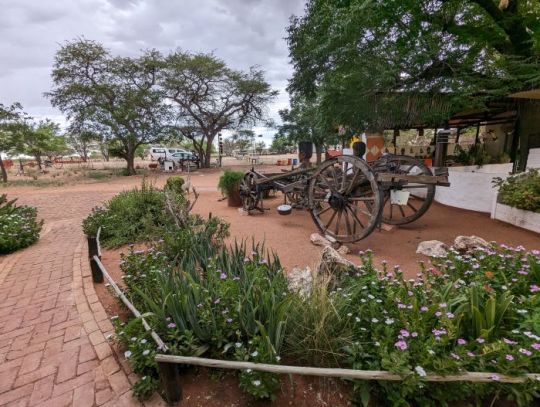
Am späten Nachmittag kommt Rainer und scheucht uns aus den Zimmern.

Abfahrt in 20 Minuten ins "Tausend Sterne Restaurant".

Mit dem alten Chevy und dem Beatle, einem selbstgebauten "Kalahari Ferrari", geht es mit allen raus zu einem Camp.
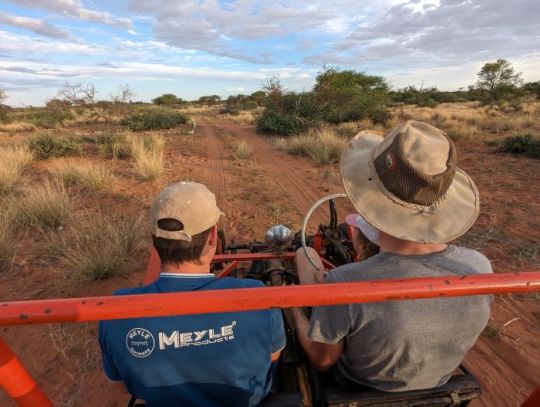
Dort gibt es eine Feuerstelle, die Rainer zurecht macht.

Hier wird er uns das Abendessen zaubern.

Es gibt Steaks vom Kudu, Kartoffeln, gebratene Zwiebelringe, Gem Squash und zum Nachtisch Vanille Flan mit Prickly Pear Saft.

Während Rainer kocht und brutzelt, kümmern wir uns mit einem Gin-Tonic in der Hand um den Sonnenuntergang.

Nirgendwo auf der Welt sind Sonnenuntergänge schöner als in Afrika.
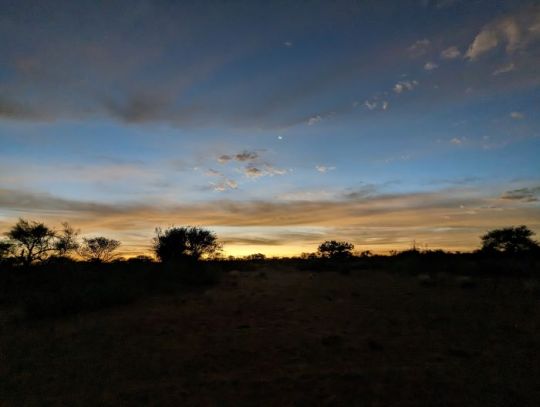
Da kann mir keiner etwas anderes erzählen.

Als es dann stockdunkel ist, holt Rainer seinen Laserpointer aus der Tasche und erklärt uns den Sternenhimmel.

Also, den südlichen Sternenhimmel natürlich.

Alle sind hin und weg.

Gegen 22 Uhr - Farmers Midnight - treffen wir wieder an der Farm ein.
Lekker Slaap!
Angie, Micha, Mama und der Hasenbär
9 notes
·
View notes
Text


Meet Neer and Vicenia. Also characters of Lore of Iasanera, but the side story "Circle of Stars"
In the Country of Odrun, there exists a small county named the Valley of Stars, a town of artists, farmers, masons and oracles worship the goddess Nix, the goddess of the Night and Stars. There exists a tree of Iasanera that instead of fruits, it bears small star moots.
There lived Neer C'Silla. A high elf of noble lineage, Neer was born and raised in the Valley. Being an elf, and of fey heritage he always had a proficiency with archery and a natural talent for nature. He had lived a couple of decades by the time he became head of the the Valley Rangers, and was about a century when he was elected a magistrate in charge of the affairs of Agriculture and Nature.
He was considered a kind soul, very wise, brave and charismatic. A natural leader who was so in tune with the Valley the head of Nix's Temple would call him him 'druid'. Which was odd as Neer was neither a druid, nor was Nix a goddess who blessed one with the powers of nature. Nonetheless the head of the temple, the Ayelid Verulene, favored Neer.
Neer was considered very beautiful and a prime bachelor, wanted by many of the elven nobility of the Valley. A noble elf, pure bread, rich and well positioned on the social hierarchy of Valley, favored by the temple of Nix and above all her very daughter, one of the most skilled and wise rangers. He had quite the array of suitors.
But Neer was in love with a plebeian cleric of Nix, the half-elf, Vecenia. The goddess Nix personally blessed the union of Neer, one of her most devoted rangers, and Vecenia, one of her most pious clerics. Verulene was furious, for she had picked Neer as her favorite. Nix quickly dismissed her daughter's claim and forbade her of harming them as she blessed their union.
They had a daughter they named Luna, in honor of Nix's favourite daughter, the goddess of the moon, Lunae.
Verulene was furious.
Against her mother's wishes she took upon forbidden magic, usinf the power of envy and jealousy, and used her mother's mantle of the night cast a terrible curse over the Valley.
Before the mantle of corrupted darkness and envy befell the land, Nix was capable plucking one star from the tree of Iasanera and gifted it to Neer, which would grant him immunity against the curse, so he could protect his brethren and above all his family. It also gave him incredible power over nature and the ability to turn into a wolf.
When he secured his rangers and a sappling of the Tree of Stars, before he could reach his wife and daughter, Verulene's corrupted minions caught him and imprisoned him. Neer was powereless to watch as the corruption destroyed his wife and daughter and killed the two.
Eventually, using newly found powers of druids, he turned into a wolf and would eventually escape Verulene's clutches. Ever since then, Neer and the Night Watch (the name given to the survivors of the curse) have been working tirelessly to prevent the spread of the curse and rescue the rest of the valley from it. But it has been a tireless and thankless job, and Neer is at his wits end.
Plagued by corrupted ghosts of Vecenia and his daughter, and the memories of the cursed. Neer departs the Valley of Shadows to try and find the fabled heroes that ended a similar shadow curse decades ago, hoping they can help him lift the curse from his home and free the spirits of his brethren and his family finally into Nix's comforting embrace.
7 notes
·
View notes
Text
🥕 - go to a farmer’s market

' ¿debimos traer más abrigado a eve? ' pregunta después de sentir una ráfaga de aire, o tal vez nix debió haber hecho caso a su esposo y asistir más abrigado. sus pasitos son lentos, deteniéndose un momento en un puesto para observar las calabazas, oportunas para la ocasión. ' ¿no te agrada la idea de unos pancakes de calabaza? ' pregunta de forma casual, aunque claramente su intención es la de disfrutar de unos pancakes preparados por el tailandés. * @cyptical
7 notes
·
View notes
Text
My Twelve Favorite (Children’s) (Chapter) Books (in no particular order and without regard for genre or intended age) and then some
Dogsbody by Diana Wynne Jones. If you are looking for perfection (and if you love fantasy), you will find it here. This also serves as a placeholder for the rest of Diana Wynne Jones’s body of work. You can’t go wrong with anything she wrote, although I do have my favorites. The audiobooks read by Gerard Doyle are fabulous.
Tashi and the Big Stinker by Anna Fienberg and Barbara Fienberg . It was like this… (The whole series is phenomenal; picked this particular one because it’s my kids’ favorite of the lot). Probably written for children on the younger side (quite a bit younger, lol) but that’s never stopped me…
The Hundred Dresses by Eleanor Estes. If you want your heart torn out in less than a hundred pages.
The Ear, the Eye, and the Arm, by Nancy Farmer. Each time I read this I find it just as thrilling as the last time.
The Grey King, by Susan Cooper. While each book in this series is spectacularly written, this one is particularly haunting. Again, be prepared to have your heart torn out by the roots.
Is Underground by Joan Aiken. An absolute gem by one of the most wildly inventive and fantastic authors to ever write for children (which obviously is saying a lot).
Lionboy by Zizou Corder. A favorite in this household. The audiobook is – chef’s kiss.
Danny, the Champion of the World by Roald Dahl. This book also serves as a placeholder for Roald Dahl, whose mastery goes without saying. The audiobook read by Peter Serafinowicz is terrific.
The Perilous Gard by Elizabeth Marie Pope. Perfectly crafted. (lol cw: quite sweet heterosexual romance)
The Westing Game by Ellen Raskin. Every time I read it, I love it all over again.
The Superlative Horse, by Jean Merrill. What is the price, and what is the value?
Captain Underpants, by Dav Pilkey. One of my kids' favorites, and mine too. The later books get a bit convoluted, but this one is so much fun.
Runners up (again, in no particular order): Code Name Verity by Elizabeth Wein, Keeper of the Isis Light by Monica Hughes, The Moon in the Cloud by Rosemary Harris, The Brilliant World of Tom Gates by L. Pichon, Dorrie's Magic by Patricia Coombs, The Worst Witch by Jill Murphy, The Blue Sword by Robin McKinley, Holes by Louis Sachar, Jack Holborn by Leon Garfield, Midnight for Charlie Bone by Jenny Nimmo, The Graveyard Book by Neil Gaiman, Merlin’s Mistake by Robert Newman, The Hobbit by J.R.R. Tolkien, Beezus and Ramona by Beverly Cleary, Grandpa’s Great Escape by David Walliams, The Changeover by Margaret Mahy, Sabriel by Garth Nix, An Episode of Sparrows by Rumer Godden, The Kidnapping of Suzie Q by Martin Waddell, The Adventures of Odysseus by Hugh Lupton and Daniel Morden, You're a Bad Man Mr. Gum by Andy Stanton (the audiobook read by the author is wildly hilarious), Harry Potter and the Deathly Hallows by J.K. Rowling, Knight's Castle by Edward Eager, The Book of Dragons by E. Nesbit.
I consider all the stories listed above to be treasures.
#children's fic list#mostly fantasy#my favorite authors#diana wynne jones#nancy farmer#susan cooper#joan aiken#margaret mahy#dav pilkey#zizou corder#roald dahl#I keep adding more#Huge shout out to the children's librarian at my local library when I was growing up. She was amazing.#edward eager#e. nesbit
8 notes
·
View notes
Note
“I know you can manage it, you just don’t *have* to.” (Rose)
high pain tolerance starters
"It's fine really- I don't feel it and mostly healed anyways." Nix collapsed on her couch; upside down to look at her. "More importantly are you free this afternoon? I heard there was an farmer's market."
#ic.#welcometothevale#<< movements of the air around >> asks#(nix 'i dont even feel it- anyways' avoidance tactics smh)
3 notes
·
View notes
Text

For Innumerable Stars 2022
Prompt by BloodwingBlackbird for the character group "Farmer Maggot's Dogs & Oromë"
Inspired by the Strength card from the Rider–Waite Tarot deck and an abundance of existential terror. More after the jump.
(Fish's note--Noodle didn't quite finish this note before life intervened but says that the gist of it is here. Having listened to endless moaning about this for the past two months, I can confirm.)
----------------------
I probably intermittently screamed for about half an hour when I saw this character group nestled amongst other (ostensibly) more... approachable groups, but I like to suffer, so I sorrowfully set aside my draft of a M*A*S*H* pastiche set in the Houses of Healing and went on a journey through the gurgling bowels of the internet.
Eventually, I somehow stumbled on the Strength card from the Rider-Waite deck:
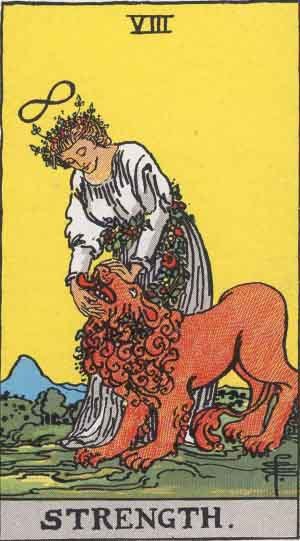
"Ah," I said to myself sagely after reading precisely half a Wikipedia article, "Yes."
The Strength card depicts a lion and a woman with a lemniscate (infinity symbol) over her head. Some cards place the woman in a more explicit position of power, while others simply have them cuddling and the like.
Wikipedia says that A. E. Waite says that this card is associated with "power, energy, action, courage, magnanimity; also complete success and honours" while, when reversed, it is associated with "despotism, abuse of power, weakness, discord, sometimes even disgrace."
"Tulkas," I mumbled feverishly, "Melkor. Trees."
Sluggishly, I plumbed Google for some inspiration on Farmer Maggot's dogs. I emerged from that dark road with nothing but their names, which I promptly forgot.
"That lion looks like a hairy dog," I said, "And sure, let's make Oromë genderously ambiguous and worry about everything else later."
Oromë, along with most of the Valar, have always felt a little sinister to me, so the initial plan was to draw Oromë smilingly slitting lion-dog's throat, with the corpses of Nahar and the other two dogs lying around in the foreground. When I proposed this to my dog-loving friend, he stopped just short of attempting to execute me, but it was a near thing.
"But dogs," I pleaded, "Hunting. Death."
"No," he replied.
Defeated, I returned to the internet for inspiration. In the pits of delirium, I stumbled upon this Wikipedia article about Sköll, a wolf that supposedly spends its time chasing the sun.
"Wolves are basically dogs, but hairier," I declared.
From there my fate was sealed. I'm not a fan of hair in general, so Oromë was given a skull to wear, and I made some half-hearted attempts at mushrooms.
As the Strength card is the eighth card in the eight card in the Rider-Waite deck, I had the brilliant idea to substitute an eight-rayed sun for the Roman numerals at the top. Suddenly, I had a draft.

Another early idea I'd had was to show Oromë being hunted by the three dogs, but that didn't seem to fit with the general theme of "Oromë, the magnanimous despot" I was going for, so I nixed it. I did want to have some sort of theme of vengeance, however, so the sköll-dog emerged from a blackened tree, which I imagined to be the withered remains of Laurelin (or even just your run-of-the-mill dead tree) to suggest the role of the Valar in the Darkening.
Time passed. Things got more dramatic. Sköll-dog became a limbless dragon-dog. I became geographically confused, found myself in Japan, and then the sun tragically lost both sunglasses and rays. Lion-dog became problematic. I helpfully forgot Nahar existed.

Eventually, I lost my mind, gave lion-dog a mushroom infection, and decided to digitally burn out the ugliest tree I have ever drawn in my life.
I'm going to take a nap now.
35 notes
·
View notes
Text
Rules: in a text post, list ten books that have stayed with you in some way. don’t take but a few minutes, and don’t think too hard — they don’t have to be the “right” or “great” works, just the ones that have touched you.
Tagged by @sparrowmoth thank you!
1. Ready okay by Adam cadre
2 six of crows by Leigh Bardugo
3 sabriel by Garth Nix
4 American gods by Neil Gaiman
5 Shadow fall by Simon R Green
6 Paper Bag Princess
7 Stiff by Mary Roach
8 the ear the eye and the arm by Nancy Farmer
9 Lotr
10 an absolutely remarkable thing by Hank Green
Tagging @njess22194 @thestarsaroundyourscars @oldguybones @oneofthewednesdays @ryneisaterriblefan @carolinawrenn
5 notes
·
View notes
Text

Happy birthday Shane :)
414 notes
·
View notes
Text
AC Server Poll (other people can vote if you want)
5 notes
·
View notes
Note
Submitted for the consideration of the childhood books poll:
East, Edith Pattou (2-book series)
Five Children and It, E. Nesbit (not sure what the series is called but it contains at least three books)
The Seventh Tower, Garth Nix
The Sea of Trolls, Nancy Farmer
The Edge Chronicles (Chris Russell, Paul Stewart)
Again, apologies if I missed the suggestion on your list; I may have accidentally skipped past something listed.
Only Five Children has been submitted before, but I just hadn't gotten to that ask yet!
It's official! Tumblr will no longer allow me to add any more to the list. I'm gonna start recording them privately in order to keep the order preserved, so any new titles will be added, just not publicly.
7 notes
·
View notes
Text
In 1893, a solid three hundred years after tomatoes were first cultivated in Europe, it took the US Supreme Court to decide whether tomatoes were a fruit or a vegetable.
At the time, imported vegetables were subject to a 10 percent tariff to protect American farmers, owing to the Tariff Act of 1883, but in 1887 a tomato importer named John Nix sued the collector of the port of New York to get his money back, arguing that tomatoes were fruits and therefore exempt. And this argument was contested for six years in escalating court battles before making its way to the nation’s highest court, where Supreme Court justices read from various dictionaries and heard testimony from expert witnesses before ultimately ruling that tomatoes were vegetables because they “are, like potatoes, carrots, parsnips, turnips, beets, cauliflower, cabbage, celery, and lettuce, usually served at dinner... and not, like fruits generally, as dessert.”
#book : secret history of food#1890s#19th century#us supreme court#food#tomatoes#john nix#usa#justice
1 note
·
View note
Text
How Authorities Erased a Historic Black Cemetery in Virginia — ProPublica
Nobody working to bring a $346 million Microsoft project to rural Virginia expected to find graves in the woods. But in a cluster of yucca plants and cedar that needed to be cleared, surveyors happened upon a cemetery. The largest of the stones bore the name Stephen Moseley, “died December 3, 1930,” in a layer of cracking plaster. Another stone, in near perfect condition and engraved with a branch on the top, belonged to Stephen’s toddler son, Fred, who died in 1906.
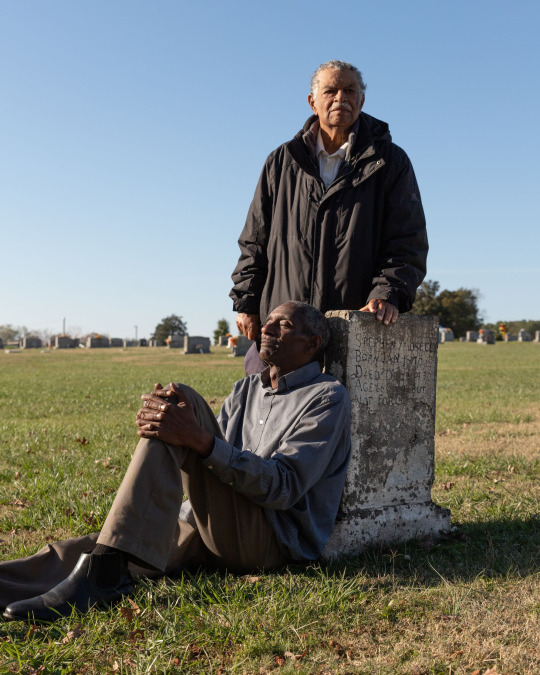
“This is not as bad as it sounds,” an engineering consultant wrote in March 2014 to Microsoft and to an official in Mecklenburg County, Virginia, who was helping clear hurdles for the project — an expansion of a massive data center. “We should be able to relocate these graves.”
Mecklenburg County, along with Microsoft and a pair of consulting firms, immediately began a campaign to downplay the cemetery’s significance. Their most urgent task was to make sure the cemetery wouldn’t be deemed eligible for the National Register of Historic Places, the federal government’s list of sites worthy of protection. That designation would likely trigger an archaeological investigation overseen by the state and could force the developers to steer clear of the graves. Without such a designation, the graveyard could be moved with relative ease.
After the discovery of the cemetery, the county and its consultants turned to archaeologists, which federal law required they retain. But that didn’t go as they hoped. In a detailed report, the archaeologists determined that the cemetery “is eligible for inclusion” on the historic registry. The report stressed the cemetery’s significance to African American life and death in Southside Virginia, citing the fact that Stephen Moseley and his relatives were Black. “It is recommended that the area be avoided,” the report said.
To the county and its consultants, whose costs Microsoft covered, this was unacceptable. “We will challenge his recommendation,” wrote Alexis Jones, a consultant with a firm called Enviro-Utilities.
The firm and the county pressed the archaeologists to reverse their conclusion that the cemetery belongs on the National Register. And they asked the team to cast doubt on the central finding that made the cemetery historically significant: that all the people buried there — members of a community of landowners who farmed tobacco in the wake of the Civil War and Reconstruction — were Black.
The archaeologists would only comply with the latter request. They edited their report to say, “It cannot be ruled out that the burials are associated with white tenant farmers.” But when they sent Jones and her boss the revised report, they acknowledged that the new assertion was dubious: “All the evidence available at this stage suggests” the cemetery was the final resting place of an African American community, they wrote.
Asked about the addition of the white tenant farmer claim, one of the archaeologists, David Dutton, told ProPublica: “We hadn’t exhumed any bodies. We hadn’t done any DNA. We hadn’t done any analysis. So could we say 100%? I mean, look, this is archaeology, you don’t know until you actually know.”
Jones and her colleagues still wanted the eligibility for the historic registry designation nixed, so they sent the report to another archaeologist, seeking a second opinion. But the archaeologist didn’t go along, and in fact he rejected the notion that some of the people buried there might be white. “Jim Crow would not have had whites and blacks buried that closely together,” he wrote.
He suggested that the original firm conduct additional historical research. “More work needs to be done on Moseley family members to identify who’s in the graves,” he wrote in an email to Jones’ boss, who forwarded it to the county.
The county and its consultants ignored the advice.
What the county had to do, because Virginia law requires it, was run a legal notice tucked among the ads and classifieds in several weekly print editions of The Mecklenburg Sun. Even that, Jones had warned in an email to Microsoft and the county, would “risk” the “chance of a local family member coming forward.”
The second week the notice ran, in November of 2014, the paper published a front-page story about a controversy over new helmets for the high school football team following the death of a player from blunt force trauma. It appeared under the byline Mike Moseley. Moseley is a staff writer. He is also Stephen Moseley’s great-grandson.
“The Moseleys have been here a long time,” Mike Moseley said of his family’s roots in that part of Virginia.
When asked if he’d seen the notice in the pages of his own newspaper, he responded: “Do you read the classifieds and the ads? I do not.”
Mike Moseley would not have been hard to locate, had the county actually tried to find Stephen Moseley’s descendants. The tall, lanky 60-year-old went to high school in Mecklenburg County and played basketball on the school team. After high school, he moved away for a time — he wasn’t interested in following his father into the funeral home business — but he returned to Mecklenburg more than two decades ago. Since then, he’s worked a series of jobs at local papers, including at the Sun, where he is still a reporter.

Mecklenburg County did not reply to detailed questions about the handling of the cemetery and the contents of the emails, which were obtained through state open records requests. But in a phone interview, County Administrator Wayne Carter said that the newspaper notice was sufficient to comply with the law. He added that he asked some people who hunted on the land if they’d noticed anyone visiting the cemetery. “They had not seen anyone down there,” Carter said.
Jones, the consultant, declined to answer questions, referring them to Microsoft. Enviro-Utilities did not respond to emailed questions and multiple calls and text messages. In response to questions, a Microsoft spokesperson said, “the County followed all applicable federal, state and local laws.”
Like his nephew, David Moseley heard nothing from the county about the threat to the cemetery. The soft-spoken retired schoolteacher and administrator, who is now 85, grew up on the land adjacent to where Microsoft was building its data center and currently lives outside of Lynchburg, Virginia. “Yes,” he said, when asked in August about his relatives’ resting place, “there’s a cemetery there.” He did not at first believe that the remains of his grandfather, Stephen Moseley, were somewhere else. “Somebody would have called me if they moved the cemetery,” he said.
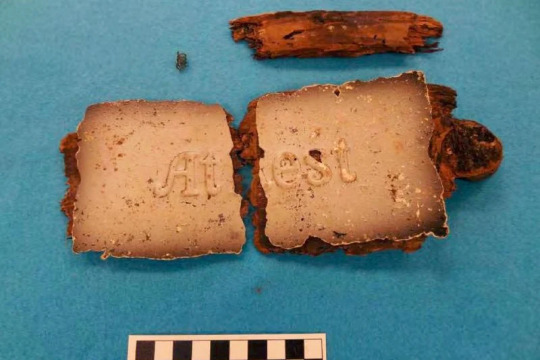
In the months after the notice that ran in The Mecklenburg Sun, workers kept finding graves, ultimately 37 of them. Some of the plots were marked with pieces of quartz or with yucca plants, which were used by many Southern Black families who could not afford stones. Each burial site added days to the excavation, to the frustration of the county and its consultants. A crew dug up each of the graves, collecting bones, casket fragments, metal handles and hinges, etched epitaph plaques, a pair of eyeglasses, an ivory comb. The remains and other items were packed in plastic crates and stored in an office. Months later, all of it was reburied in four tightly packed, $500 cemetery plots one town to the north.
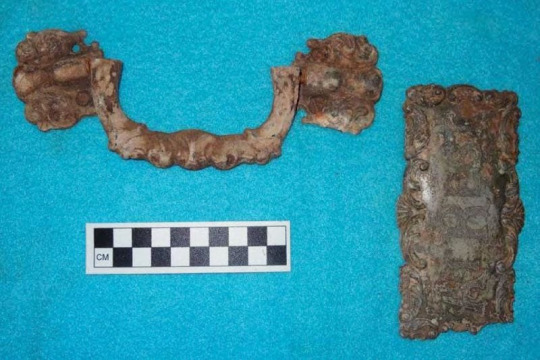
David Moseley’s grandparents, Stephen and Lucy Moseley, and great-grandparents, James and Ellen Walker, in 1899 purchased 169 acres in a fertile region near the North Carolina border. His father, Douglas Moseley, inherited the Moseley homestead, and as a teenager, David woke in the early mornings to work with an uncle harvesting their tobacco crop. As far back as David knew, his ancestors had been buried on that land. In one of his earliest memories, from when he was about 4, he joined his parents in the graveyard to bury his stillborn sibling. “I remember being out there and the open grave,” he said.
David, along with his last living sister, Christine Moseley, and their children, nieces and nephews, still own the eastern 83 acres of the property, which they call “the farm.” The family sold the adjacent tract, which Microsoft now owns, generations ago; David said his family entered a handshake agreement with the white people who bought the other half of the property that allowed the Moseleys to continue to visit the graves. Today, the farm is surrounded on nearly every side by land zoned for industrial use, including three of the 17 parcels that Microsoft has acquired in Mecklenburg County for the ongoing expansion of its data center there. Every so often, David Moseley or his niece who lives outside Washington, D.C., gets an offer to buy their remaining land. Sometimes the correspondence is signed by Wayne Carter, the county administrator who oversaw the permitting process for the Microsoft data center.

The cemetery’s disappearance proceeded despite layers of federal and state regulations nominally intended to protect places like it and to facilitate consultation with people who might have an interest in what happens to historic sites.
But in Virginia, as in most of the country, the power over what ultimately happens to these sites often belongs to whoever owns the land. And the labor of investigating what could make the site historic is often outsourced to for-profit archaeological firms working for property owners who have a financial stake in finding as little as possible.
“We are among the only developed countries in the world that considers archaeological sites on private property to be private property themselves rather than cultural heritage,” said Fred McGhee, Ph.D., an African American archaeologist in an overwhelmingly white field.
“Black historic places are some of the first to get maligned,” he said.
African American cemeteries that are deemed abandoned or untended have routinely been treated as little more than a nuisance in the path to development. Historic preservation laws and regulations rarely protect them.
On the campus of the University of Georgia, builders discovered a cemetery of enslaved people, and in 2017 the remains were reportedly loaded onto a moving truck and reburied “in secret,” according to a faculty review. In Texas in 2018, the graveyard of dozens of men held as convict laborers, a site whose significance was long known to community members, was found by construction workers, and the remains were exhumed. In each case, the developers have said they treated the burials with dignity.
Earlier this year, an agricultural company called Greenfield LLC applied for a federal permit to build a Statue of Liberty-sized grain transfer facility on 248 acres along the Mississippi River in Louisiana. An archaeological firm had initially concluded that the development put several notable Black historic sites, including a restored plantation that serves as a memorial to enslaved people, in harm’s way. But in May, ProPublica revealed that the firm changed its report to back away from that conclusion after facing pressure from its client. The firm told ProPublica at the time that no one had forced it to make the revisions and that the report itself was a draft, noting that drafts often change “after clients review them.”
Without first consulting the communities that live beside the development site and trace their ancestry to the people enslaved on the same land, the Army Corps of Engineers, the agency considering the permit, allowed Greenfield to drive enormous metal beams into a sugar cane field — even before the Corps signed off on the project. That field, researchers and community members say, likely holds unmarked graves of people who were held as slaves. Greenfield has said that it considers the protection of historic sites a priority and that it would stop construction if any such sites were discovered.
For decades, the Army Corps has been criticized by other federal agencies, advocates and community and tribal organizations for failing to engage with affected groups about potential damage to cultural sites, as the 1966 National Historic Preservation Act requires.
“The way this is supposed to work is that the Army Corps, or whatever federal agency is issuing a permit, should have told the developers that the descendant community needs to be identified and interviewed and that their perspectives need to be taken into account,” said J.W. Joseph, an archaeologist with New South Associates, a cultural resources firm in Georgia that has done archaeological work in dozens of cemeteries, often as part of projects regulated by the federal law.
“Far too often, that doesn’t really happen.”
In Mecklenburg County, before Microsoft took possession of the land — for free, with significant tax breaks, along with state development dollars earmarked for struggling tobacco farming regions — the Army Corps raised no concerns about the development’s compliance with the Preservation Act. Nor did the Virginia Department of Historic Resources, the agency tasked with enforcing state and federal preservation laws, make any effort to step in and protect the site. (The department said it has never denied a landowner application for a reburial permit and preservation experts said Virginia judges almost never do either.)
The Army Corps and the Department of Historic Resources facilitated the cemetery’s legal erasure. The graves were dug up in near silence.
“Although the Department’s position is that those laid to rest should be left undisturbed,” a Department of Historic Resources spokesperson said, “we also understand that this is not always possible.”
Once they had permission from the state Department of Historic Resources to excavate the remains, Microsoft, Mecklenburg County and its consultants showed little concern for anything other than speed and cost. It was a rainy spring in 2015, and the ground was soaked. The graves that an excavation crew dug open would sometimes fill with water. According to one crew member, Eric Mai, who had recently started a master’s program in archaeology, the already-fragile remains were further degraded — exposed, sometimes for days, to the wet muck.
Everyone knew it was the wrong time for the work. “The conditions on site are about as bad as they can be for exhumation,” Jones, the consultant, wrote to Microsoft and the county, explaining why the dig was taking longer than expected. “It’s a nasty sticky wet clay,” she said of the soil that had primed the land decades ago for prolific tobacco yields. But Jones pressed the gas. “THEY need [to] find additional help and work 7 days a week until it is done.”
The “remains were saturated and in very poor condition,” according to a report by the firm hired to do the excavation, Circa-Cultural Resource Management LLC. The Department of Historic Resources agreed with Circa that there wasn’t enough physical matter left to justify sending the bones to the Radford University forensic anthropologist they’d planned to hire to study markers of age, race and sex. It “would probably not add any new information to the record,” a Circa report said.
“WAYNE, this is a GOOD thing!” Jones, the consultant, wrote to Carter, the county administrator. “This would be a huge money and time savings for us.” (This year, Jones took a job with Microsoft, as an environmental permitting program manager, according to her LinkedIn profile.)
Mai said in an interview that he worried that in the rush to dig up the Moseley cemetery, the Circa team may have missed important artifacts and grave offerings. “I think it would probably be concerning for descendants to learn that the people out there doing the work, me included, did not really know what we were looking at,” said Mai. “Nobody on the team knew anything about African American burials.”
Circa CEO Carol Tyrer wrote in response to questions that the team members did have “knowledge of African American cemeteries and burial practices.” Tyrer referred other questions about the Moseley cemetery excavation to Microsoft.
In part because of his ethical concerns, Mai left the field of for-profit archaeological and historic survey work. “There is a disrespect in this process,” Mai said recently. “The people, the descendants, are not really part of what we do.”
Had the county or any of its consultants made more of an effort to determine who they were digging up, they might have learned from public death certificates and census records that in one of the graves lay the remains of Ellen Walker and likely her husband, James Walker, the parents of Lucy Walker, who married Stephen Moseley, a preacher’s son from one county away. They might also have found living relatives like Mary Taylor, who is now 83 and is one of Stephen and Lucy Moseley’s many great-grandchildren. She lives in Norfolk and keeps a worn folder full of records showing that one of her mother’s brothers was buried in the Moseley cemetery. They might have come upon the records of other cousins and aunts and uncles by marriage, who formed their own branches of the family tree, whose descendants still own other plots of land in Mecklenburg County, and who appear to have been laid to rest there, too.

Once the dig was complete, the Army Corps told Mecklenburg County that it had met its obligations under federal law. Construction crews leveled the ground where the cemetery had been. Ownership of the land was transferred from the county to Microsoft.
In response to questions, the Corps wrote that it had consulted with the Department of Historic Resources and with Mecklenburg County before issuing the permit. A spokesperson also stated that the Corps had posted a notice on its own website around the same time the county ran its notice in the Sun “soliciting comments on the project.” Nobody responded.
Aerial photos of Mecklenburg County going back to the 1990s show rows of evergreen trees that wind across both of the old Moseley plots like the whorls and arches of a thumbprint. Then, in a 2016 satellite image of the terrain, the contours of trees and their center point have disappeared. A row of rectangles, the backfilled graves, appear in the tan earth. By 2020, an aerial view shows only an undeveloped dirt patch on the far eastern edge of the Microsoft site, just over the line from the land the Moseleys still own.

In 2019, four years after the Moseley cemetery was dug up, Mecklenburg County began building a sorely needed new middle and high school. On the uncleared land, surveyors discovered a cluster of headstones inscribed with the last name Tunstall, a white family with a long history in the region. The graves would need to be moved for construction to proceed as planned, and the school board put a notice in the newspaper, like the one that had been placed about the Moseley cemetery. But in this case, the relocation was also discussed in open school board meetings. A construction firm that worked on the project trumpeted its effort to help find relatives.
A Mecklenburg County sheriff’s deputy named Dustyne Lett saw the news of the cemetery on Facebook. She is a descendant of the Tunstalls.
“By us being involved, we could have a say about where they would be moved,” Lett said recently.
A county judge issued an order giving the school board permission to disinter the remains. They were reburied in a family cemetery several towns away.
“Family members need to be buried with family members,” Lett said. “It’s not like they get together to have dinner. But for us living people, we want to have one spot where we can visit them, talk to them.”
David and Mike Moseley do not imagine that they would have won a fight against Microsoft or the county to keep the cemetery where it was, though they would have wanted the chance to wage one. They also were denied the chance to decide where their ancestors would be reburied.
“We would have wanted them to be moved here, where the rest of the family is,” David Moseley told me when we met in the Jerusalem Temple United Holy Church Cemetery, where the Moseleys have buried their relatives since the 1960s, after they moved off the farm. David’s sister Dorothy Tolbert, who passed away in New Jersey in May, is buried there, not far from Lucy Moseley’s grave — a grave that had been publicly logged online three years before the Microsoft project. “That would have been respectful, that would have allowed them to be together,” David said. In 1967, when Lucy Moseley died at the age of 96, relatives figured moving her husband’s grave to the Jerusalem Temple cemetery would have been too expensive. They would let their ancestors rest in peace.

State and local officials have actively worked to honor and preserve white cemeteries in Mecklenburg County. In a 2003 book about the successful effort to have several historic town centers listed on the National Register of Historic Places, the view from a white cemetery is described as “bucolic.” That view has been protected by a Virginia historic preservation easement. Another cemetery, with only three visible stones, is noted for its impressive gateposts, which are inscribed with the words “Love Makes Memorial Eternal” and which were donated in 1941 by the United Daughters of the Confederacy.
In August, I met David and Mike Moseley to look for their relatives’ reburied graves in a cemetery in Chase City, 15 minutes north of the Microsoft data center. The final excavation report had said there would be a marker placed “indicating how many remains, where they were removed from, date, and known family names.”
We drove slowly through the cemetery, looking for a sign. We did not find one. Over lunch at a local restaurant, we called the Chase City municipal office. A clerk told us that she thought she knew what we were talking about; in the new section of the town cemetery, past the mausoleum, we’d find “the graves the county sent.”
“There are no names. It just says ‘assorted bones,’” she said, reading off a paper on file in the town office. She gave us directions, listing the names on several other stones in the vicinity of the reburial plots.
Past the mausoleum, we spotted a grave with one of those names and stopped the car. David peered out the window. “I know that stone,” he said quietly. “It’s been a long time since I’ve seen it.”

Stephen Moseley’s gravestone had been set in the ground. Six feet to the right stood the stone of his toddler son, Fred D. Moseley. There is nothing noting the existence of any other remains, just an unmarked stretch of grass.David and Mike Moseley placed their hands on the top of Stephen’s gravestone. “I would not have known where he was buried,” Mike Moseley said, repeatedly, and then sat down in front of the stone, his hand still resting on the top, and cried. Being here with them now, he said, “this connects us.”
#How Authorities Erased a Historic Black Cemetery in Virginia#mecklenberg county#Black History Matters#Black Cemeteries Matter
8 notes
·
View notes
Text
I had a thought last night. Would anyone be interested in hcs or interactions of characters that don't interact but are in the same universe? Like Jackson going to Nix for a coffee, the winter boys storming (haha) Caleb's bakery because he has a donut sale going on, Miles and Kamesh selling their goods at farmers markets, etc...
Would anyone be interested? <:3c
6 notes
·
View notes